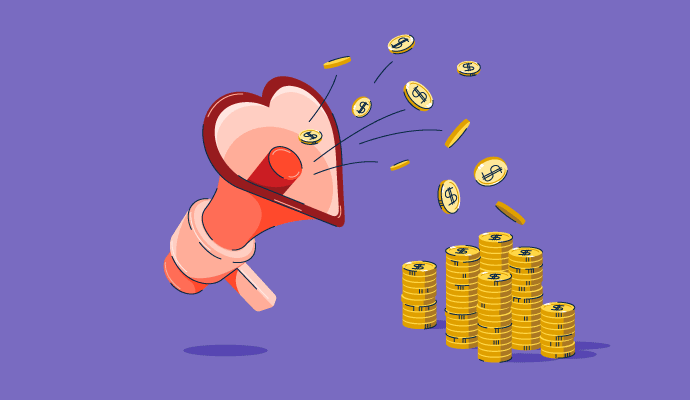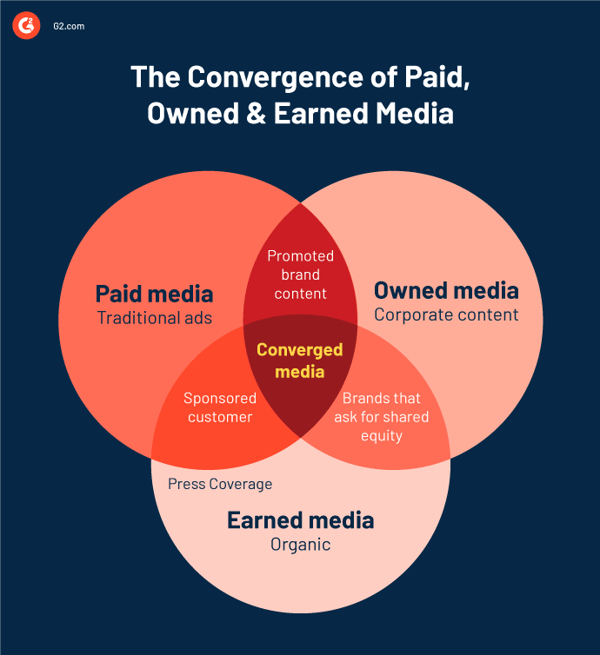February 27, 2023
 by Deirdre O'Donoghue / February 27, 2023
by Deirdre O'Donoghue / February 27, 2023

Give your brand the upshot it needs to survive.
Imagine Stephen Curry being sent to the baseball ground. Would he score a home run? Contrarily, he might shoot the "baseball" for a slam dunk. He won't care for different rules for any sport other than basketball.
Every sport is represented by skilled professionals. Stephen Curry is the chosen gem of the Golden State Warriors. Or in other words, their earned media resource.
Your brand is your basketball team. Holding it upright in the market community increases earned media share. These are non-biased, organic content assets that can make you go from zero to hero. Brands need an upshot of earned media to make others believe in their product.
Monitoring your media returns via media monitoring software tracks your collaboration projects, news feeds, and deal insights to be at par with online brand runners.
Earned media, also referred to as free media, is publicity gained through promotional efforts for which you haven’t paid or created yourself. Earned media is acquired through the constant tussle of PR and brand promotion teams. They buckle up and promote your brand in the limelight to fetch you a ton of organic resources.
It’s the job of public relations and marketing teams to get their clients’ media coverage. With every company doing the same thing, consumers often tune out all the noise on various media outlets. Earned media splits the difference between what is an authentic brand effort and push tactics.
The ad space of a particular brand comprises two more names: paid media and owned media. Owned media is your patronized and patented content that you have full ownership of. Paid media is fed to custom audience lists on Google and Facebook that interact with the kind of product you specialize in.

Having an influenceable share of voice (SOV) through earned media can get you through to the ideal target group. Further, with the right sorts of organic link-building and PR pitches, you might dominate search engine results pages (SERP) and reach a brand pinnacle.
Earned media doesn't stench your marketing budget. It is a free monetization tool that can help you gain organic growth.
Earned media, owned media, and paid media is crucial to a successful marketing strategy. Together these types of media create more opportunities for messages to be heard. They create a ripple effect to turn the heads of your prospects toward your brand. The cohesion of all marketing and newsroom opportunities adds to your treasure of successful return on investment (ROI), maybe even greater than you expected.
Not only PR slideshows can bring in marketing or brand partnerships. There are other ways to influence your brand shares with the media triathlon.
Earned media vs. owned media vs. paid media
The ultimate goal of media is unilateral: to bring relevant traffic back to the official website. However, brands like to run their marketing horses up to speed with each other. Let's look at the different types of media coverage a brand invests in.
-png.png?width=600&height=333&name=Copy%20of%20X%20vs%20Y%20vs%20Z%20(10)-png.png)
Earned media is the public recognition and visibility your brand gets with PR and brand marketing stints. It gives you room to grow your brand, both in and away from the media spotlight. The constant efforts your PR agents put in help you welcome newer sponsorships, reviews and ratings, guest and speaker mentions, and high domain rate (DR) backlinks.
Examples of earned media
1. Review sites: Positive or negative product experiences that your users have gained, for which they leave a word on your website.
2. Organic backlinks: Earned links through content promotion, guest posting, and off-page SEO outreach.
3. Word of mouth: Honest and truthful recommendation of your product by one customer to another person in a social circle.
4. Podcast mentions: Getting brand mentions in community podcasts, webinars, digital conferences (Like G2 Reach), guest posts, sponsored videos, and so on.
5. Guest posts: Earned blogs written by distinguished market leaders for your website domain.
6. Expert roundups: A quote or a conversation snippet from an established market leader that is included in your content piece.
7. PR coverage: Gaining the right kind of PR coverage (like through HARO) to crowdsource your content and enhance influencer relationships.
8. Thought leadership content: Creating cream of crop content inspired by personal experiences, learnings, and research.
9. Social media mentions: Coveted shout-outs by reigning leaders of the industry on social media.
10. Search engine snippets: A relevant section of your website that shows up in the return of a search query typed by the user.
Paid media are paid advertisement campaigns you bid your money on to generate relevant traffic. You pay to advertise your brand across multiple channels to generate impressions, clicks, page views, form submissions, and lead generation. Usually created by an advertising agency, your brand can control the ad copies and products it wishes to target. Paid media is a great way to gain brand awareness if you launch a new line of products or services.
When choosing what type of paid media to place your ad dollars in, be sure to have a researcher determine where your audience is. Then work carefully to craft messaging that is attention-grabbing and impactful.
Examples of paid media include:
Owned media is anything owned and created by the business, allowing for direct control. These are web properties that you own across offline and online marketing channels to engage with your prospects. Examples are websites, product blogs, sales enablement resources, social media channels, and blogs. Channels like social media and blogs are extensions of your website. The more owned media you have, the more chances you have to extend your brand presence in the digital sphere.
Businesses invest a lot of time in these channels because, without them, there would be fewer opportunities for earned media. Owned media provides value to users rather than pushing them with promotional messaging.
Examples of owned media
It takes time to build the types of owned media, but once you do, you’ll have cost-effective, versatile, and easy-to-control content for your audience to engage with. Establish these types of owned media for marketing success:
Earning media is all about grabbing and holding the attention of media gatekeepers, such as bloggers, influencers, and reporters. It is the constant helm of efforts that your marketers put in for your brand. They decide what would be the right time to bring the product into the market or to meet the sponsor. Whatever you get in return, tangible or nontangible counts as earned media.
The strong aspect of earned media is influencer marketing. Promoting your owned content on its own might take years. But leveraging it through an influencer can give you multitudes of traffic share in days. They can advertise, discuss and publish your content for their own audience (which means your content would reach other people's audience) and give you the boost you need.
The main way to gain earned media is through making connections with the gatekeepers. Follow them on Twitter, Instagram, or other forums, email them about a piece of work you really liked, and engage with their social media content— any way you can think of to gain their trust will help you to earn media. Bolstering ties with influencer also need correct audience analysis. If you are a Fashion&Lifestyle company that is promoting its reselling or thrift shopping platform, you need to get in touch with fashion bloggers who post regularly for the same interest.
Having earned media as a baseline for your influencer marketing strategy can promise more returns. You can look into the performance of your influencer's marketing strategy, ad clicks, impressions, CTR, and organic source attribution of traffic. You can get the data from a badged social media partner (like Instagram Marketing Partners)
Evaluating the current influencer campaign can help you make strategic decisions for brand awareness and ROI.
Creating great content is another way to get the attention of the press. Any initiatives your company has or is involved with can be hyped with the right form of content marketing. Send your writers and journalists on-site to create stalwart pieces of content. TOFU articles, blogs, social media marketing, and community podcasts that people so righteously follow are nothing but ways to earn media for brands. It gives a bank shot of a brand in a certain market and, with a relevant review mechanism, reinstates customer value.
Lastly, tapping into your brand loyalist and advocate base is another way to get earned media. These people are first in line to cheer you on and share your news, and if you’re lucky, an influencer could be a fan and skyrocket your qualified marketing leads (MQL).
Earned media is particularly important to public relations professionals because it establishes and builds your reputation in the public eye. What they say or do out in public can make or break your brand. Inform them about the last PR audit, hand them over specific content scripts, and help them outsource their workloads.
Are you attributing correct content channels to accommodate your product? When it comes to generating qualified leads, do not just depend on your top-of-the-funnel content assets. Sure, traffic via blogs, social media marketing, and guest posts is organic and high value, but they seldom convert. Earned media translates into "media you need to earn and build." Thus, without an omnichannel distribution strategy, earned media is a far cry.
Create topic-specific webinars, invite distinguished speakers via speaker mails, generate thank you letters for your stakeholders, and encourage employees to share your newsletter. Newer, fresher ways of creating content can make a real difference. Since the distribution channels are authentic, the lead influx would be 100% guaranteed, and gross margins would be higher.
4. Establish and demonstrate expertise
Your PR professionals need to hone their research and development skills to be able to have a high standing in the market. The market is filled with competitive go-getters that will ban new entries. How you break through it as a brand and correspond your offerings is important to earn media coverage. Simply holding a mic or a pen to favor your brand will lead you nowhere. Until and unless you don't exude confidence and batter the most challenging questions, you won't be called an expert.
Make yourself a research expert by constantly digging deep into a particular subject. Even if you do not belong to that persona or niche, you can go a step further for the sake of the buyer. Your buyer wants questions to be answered. He might not be interested in technical facts and surveys as much as he trusts the author's experience and knowledge. Build on buyers' curiosity by creating thought leadership content, which nudges them in the right direction.
There is no set framework for the calculation of earned media. It all depends on how many newsrooms your PR agencies have hit and what end benefit you have achieved. Something as simple as an ad impression (users who opened and viewed your ad) can be counted as earned media. Testimonials from different prodigies that add up to your site value are counted as earned media. With a metric so diverse and uncountable in nature, there is no correct derivation.
However, some companies calculate earned media by setting a content performance benchmark against competitors. They build month-over-month traffic goals, the share of voice (SOV), backlinks, domain score, etc. Relying on these broader metrics gives them a clear picture of their web behavior. However, other companies focus less on the traffic aspect and more on click-through rates, impressions, and engagement rate to measure the interest of the buyers.
To analyze your earned media value, know your running ad cost and impression CPM (cost per thousand impressions). Factor in previous campaign metrics to arrive at an answer.
EMV = Impression CPM* free impressions delivered/1000
Your sponsors won't invite you for lunch until you don't convey your food preferences. Take the plunge into an infectious world of brands, and try to navigate your way out. With the correct PR coverage and PR team, your brand will have enough revenue to fund its own lunches in the future.
Don't sit and wait for time to pass by! Get started with brand marketing to make your own dominance in the market sphere.
This article was originally published in 2019. It has been updated with new information.
Deirdre O’Donoghue is a Content Manager at Nature's Fynd and a former Content Manager at G2. In her free time, you can find Deirdre fostering puppies or exploring the Chicago foodie scene. (she/her/hers)
Where are people getting their news?
 by Deirdre O'Donoghue
by Deirdre O'Donoghue
Journalists don’t have time for your pitches.
.png) by Shreya Mattoo
by Shreya Mattoo
Social media is essential for building your business online.
 by Yash Chawlani
by Yash Chawlani
Where are people getting their news?
 by Deirdre O'Donoghue
by Deirdre O'Donoghue
Journalists don’t have time for your pitches.
.png) by Shreya Mattoo
by Shreya Mattoo


